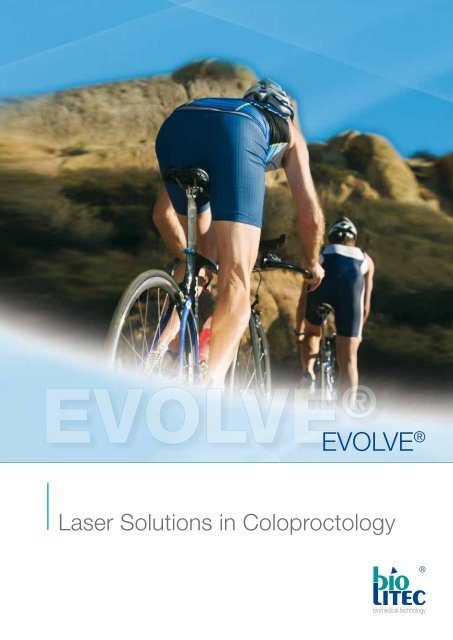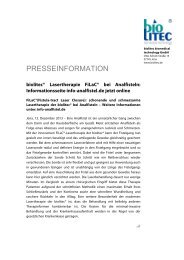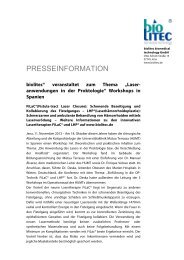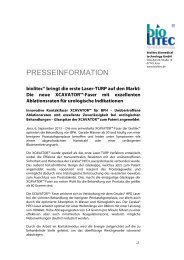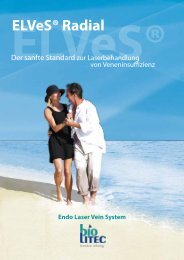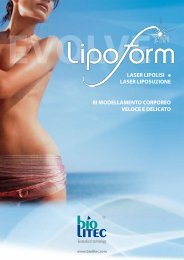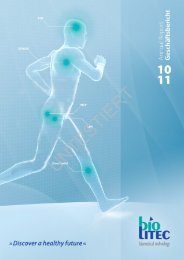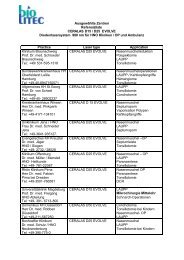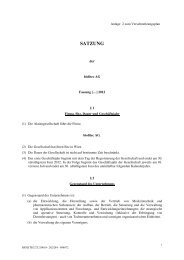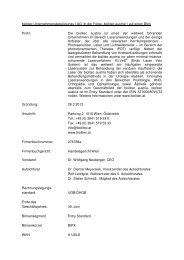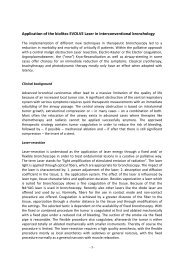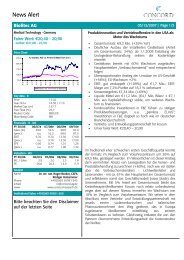FiLaC - biolitec AG
FiLaC - biolitec AG
FiLaC - biolitec AG
You also want an ePaper? Increase the reach of your titles
YUMPU automatically turns print PDFs into web optimized ePapers that Google loves.
EVOLVE ®<br />
EVOLVE ®<br />
Laser Solutions in Coloproctology<br />
®<br />
biomedical technology
EVOLVE ®<br />
Our Laser Solutions in<br />
Coloproctology<br />
®<br />
biomedical technology<br />
HeLP ®<br />
Ambulatory Laser Treatment<br />
of Hemorrhoids<br />
<strong>FiLaC</strong><br />
Fistula-tract Laser Closure<br />
LHP<br />
Laser HemorrhoidoPlasty
HeLP ® <strong>FiLaC</strong> LHP<br />
Safe, Effective and Fast<br />
HeLP ® - for hemorrhoids<br />
HeLP® is the least invasive of surgical procedures for hemorrhoidal<br />
dearterialization for curing hemorrhoids. HeLP® uses an integral<br />
procedure kit specially designed by <strong>biolitec</strong> to achieve a treatment<br />
that is fast, painless, and above all, simple and reproducible by the<br />
surgeon.<br />
<strong>FiLaC</strong> – for anal fistulas<br />
The aim is to gently remove the fistula tract without damaging the<br />
sphincter. Thus, any parts of the muscle are preserved to a maximum<br />
and incontinence is avoided.<br />
LHP - for hemorrhoids<br />
This approach is used for advanced hemorrhoids under appropriate<br />
anesthesia. The energy of the laser is inserted centrally through a<br />
radial emitting fiber into the hemorrhoidal node.<br />
Proctological Laser<br />
Applications
Hemorrhoid<br />
treatments<br />
Doppler assisted Laser<br />
Ligation of the Arteries<br />
2nd and 3rd Degree<br />
The HeLP ® proctoscope is designed for easy insertion<br />
into the anal canal. It consists of a working channel<br />
containing the disposable HeLP ® Doppler probe, which<br />
identifies the branches of the superior hemorrhoidal<br />
arteries above the dentate line.<br />
The laser energy is then applied to each of the sub<br />
mucosal branches using the handpiece of the special<br />
HeLP ® fiber. Laser photocoagulation of the branches<br />
closes the superior hemorrhoidal arteries and decreases<br />
the pressure in the hemorrhoidal piles. In this way the<br />
arterio-venous flow is modified leading to withdrawal of<br />
the piles on subsequent days and weeks.<br />
The perfect Solution for Patients<br />
®<br />
biomedical technology<br />
The perfect relief/solution for patients<br />
fearing invasive painful surgical or<br />
semi-surgical techniques in this<br />
delicate matter. Especially if the<br />
patients are fed up with rubber band<br />
or sclerosation this easy and accurate<br />
application is the right alternative. It is<br />
an ambulatory approach and serves<br />
you with fast procedures needing just<br />
one intervention.<br />
Combination HeLP ® and LHPTM You might as well combine both<br />
approaches to optimize patients<br />
benefit. By previously closing the<br />
feeding arteries bleedings will<br />
be suppressed to a high extend<br />
improving all subsequent measures<br />
to further reduce the symptoms of<br />
hemorrhoids.
No Incisions, No Stitches, No Open Wounds<br />
Case 1 Pre-OP<br />
Case 1 Post-OP<br />
Case 2 Pre-OP<br />
Case 2 Post-OP<br />
Laser hemorrhoidoplasty<br />
(LHP)<br />
3rd and 4th degree<br />
If immediate removal/reduction of the hemorrhoidal cushion is<br />
indicated (no matter if it is segmental or circular) this therapy will<br />
provide you with an improved patient outcome especially regarding<br />
pain and down times compared to conventional surgical proceeding.<br />
Under proper local or general anesthesia the controlled laser energy<br />
deposition obliterates the nodes from the inside and preserves the<br />
mucosa and sphincter structures to an extremely high degree.<br />
The radial and homogenous laser emission required for this<br />
procedure results in:<br />
• Tissue reduction in the hemorrhoidal node<br />
• Maximum preservation of muscle, anal canal lining and mucosa<br />
• Restoration of the natural anatomical structure<br />
Use of laser hemorrhoidoplasty probe (LHP) enables the endoluminal<br />
laser coagulation of both segmental and circular hemorrhoidal nodes.<br />
The controlled emission of laser energy, which is applied to the<br />
submucosa, causes the hemorrhoidal mass to shrink. In addition,<br />
fibrotic reconstruction generates new connective tissue, which<br />
ensures that the mucosa adheres to the underlying tissue. This also<br />
prevents the occurrence or recurrence of a prolapse.<br />
No foreign materials (clamps) need to be inserted and, unlike other<br />
procedures, LHP is not associated with any risk of stenosis.<br />
Healing is excellent because, unlike conventional surgeries, there are<br />
no incisions or stitches. As a result, the patient experiences less postoperative<br />
pain and can return to normal activities within a shorter<br />
space of time.<br />
Maximum Preservation of Muscle,<br />
Anal Canal Lining and Mucosa
<strong>FiLaC</strong><br />
Fistula-tract<br />
Laser Closure<br />
After therapy of the abscess<br />
and Seton drainage the fistula<br />
has epithelised<br />
Maximal Preservation of the Muscle –<br />
Preservation of Continence<br />
®<br />
biomedical technology<br />
After conventional closure of the<br />
internal fistula opening the probe is<br />
inserted into the fistula tract<br />
Homogeneous application of laser<br />
energy radially into the lumen of<br />
the fistula. The epithelised tract is<br />
destroyed and collapses rear the<br />
probe head<br />
• Good control<br />
• No excision or splitting<br />
• Independent on the length of<br />
the fistula tract<br />
• Flexible fiber also allows use in<br />
convoluted tract<br />
• Can be executed in only a few<br />
minutes<br />
• Can be combined with other<br />
forms of therapy for closing the<br />
osteum
Optimal Use of Laser Energy<br />
In order to eliminate the fistula tract as gently as possible the flexible,<br />
radial emitting laser fiber is inserted from the outside and positioned<br />
exactly by using the pilot beam. Defined energy is being emitted<br />
radially into the fistula. The epithelialized tissue is being destroyed in a<br />
controlled way and the fistula tract collapses. This also supports and<br />
accelerates the healing process.<br />
<strong>FiLaC</strong> fiber<br />
The <strong>FiLaC</strong> fiber applies energy adapted to the pathway of the<br />
fistula tract.<br />
The 360° energy emission ensures homogenous photothermal<br />
destruction of the fistula tract, allowing safe closure.<br />
The efficient radiation concept of the <strong>FiLaC</strong> fiber makes optimal<br />
use of the laser energy applied.<br />
Optimal monitoring of the fiber tip is possible thanks to its excellent<br />
ultrasound visibility (if applied).<br />
Efficient Radiation Concept
<strong>FiLaC</strong><br />
Fistula-tract<br />
Laser Closure<br />
© By courtesy of Dr. med. A. Wilhelm<br />
Ceralas ® E Laser<br />
®<br />
biomedical technology<br />
3-D ultrasound illustration of a trans-sphincteric anal fistula at 12<br />
o‘clock (Contrast enhancement via H2O2)<br />
Ultrasound image direct after advancement flap. In the area of the<br />
former inner opening in the Musculus sphinkter ani internus strong<br />
echo-reactions can be seen due to the applied laser energy.<br />
The protecting flap can be seen as isoechoic zone beneath.<br />
Ultrasound image 5 days post-op. In the treated area the hyperechoic<br />
regions are vanished and form a hypoechoic district. The dimensions<br />
correlate to the original fistula tract and display the entrance depth of<br />
the laser. It also shows the safe application of the laser and short term<br />
wound healing.
EVOLVE ®<br />
HeLP ®<br />
Literature<br />
Clinically proven:<br />
Patients and methods: In the past three years, 200 patients were<br />
treated with Doppler-guided laser photocoagulation of hemorrhoidal<br />
arteries. In all cases, treatment was performed on an outpatient basis<br />
and anaesthesia or analgenesia was not necessary.<br />
Results: Mild intra- and postoperativecomplications were seen. 91%<br />
of the patients show an improvement of hemorrhoidal symptoms 1 to<br />
12 months after treatment.<br />
Conclusion: Doppler-guided laser photocoagulation of hemorrhoidal<br />
arteries is a good an safe method for the ambulatory treatment of<br />
hemorrhoids.<br />
Raffaele Salfi, coloproctology 2009;31:99-103<br />
<strong>FiLaC</strong><br />
Material and Methods: In a pilot study we<br />
operated on 10 (8 male – 2 female) patients. Median<br />
age was 51 years (38 – 65 years). There were only<br />
cryptoglandular fistulas with either two type 4 and<br />
3, five type 2 and 1 type 1 fistula. All patients had<br />
previous surgery due to perianal abcess and fistula<br />
up to 6 times prior to definitive surgery. First, all<br />
patients had drainage of their perianal abscesses<br />
and seton draining of the fistula.<br />
Primarily, the outer an internal opening of the fistula<br />
were excised. Following, an advancement flap was<br />
prepared, if possible. By applying energy the fistula<br />
tract was obliterated under continious retraction of<br />
the laser At last the flap was placed to cover the<br />
former internal opening.<br />
Results: Median follow up was 6.4 months. 8 out<br />
of 10 fistulas healed (80 %). One fistula persisted in<br />
a patient with a type 4 extrasphincteric fistula and a<br />
second one in a patient with a transphincteric fistula<br />
following complicated drainage of a horseshoe<br />
abscess. Only one minor form of incontinence<br />
(soiling) was observed and no major or minor<br />
complications occurred.<br />
Summary: In summary, anal fistula repair using<br />
a newly designed radial emitting laser probe in<br />
addition to conventional surgery is a very promising<br />
original technique in sphincter preserving anal fistula<br />
repair. The observed healing rates along with the<br />
results for postoperative continence were excellent.<br />
No complications have been observed.<br />
Dr. Arne Wilhelm,Techniques in Coloproctology<br />
LHP<br />
Patients and methods: In the period between<br />
01/2006 and 10/2009 a total of 332 patients<br />
were operated with this method by using a<br />
980nm diode laser. Hemorrhoidal tissue is being<br />
destroyed submucosally by a special radial<br />
emitting fiber. The vascular convolute is made<br />
desolate and there is fibrotization of the tissue.<br />
On some of the patients in addition to interstitial<br />
irradiation of the cushions mucopexy of all<br />
segments was done.<br />
Results: The operation executed under<br />
daysurgical circumstances in lithotomy position<br />
took an average of 17.4 min for all three segments<br />
(from inserting the proctoscope to applying the<br />
tamponade). The average period of disability<br />
with the LHP method was 4.2 days and in<br />
combination with mucopexy 7.4 days. Within the<br />
post-operative follow-up period of 6-36 months<br />
a prolapsed node could be found in 5.8% of<br />
all patients examined (one or more 2nd degree<br />
nodes).<br />
Conclusion: The LHP method represents another<br />
alternative for existing methods. The complication<br />
and recurrence rates as well as operating time are<br />
not longer compared to conventional techniques.<br />
Especially the work mode which preserves<br />
the anoderm and reduces hemorrhoidal tissue<br />
painlessly and without many complications is of a<br />
big advantage. The mucous membrane remains<br />
intact and the natural anatomy can be restored.<br />
Dr . A. Karahaliloglu, Coloproctology 2010, 32:116-123<br />
Unmatched Performance in<br />
Speed, Safety and Effectiveness
HeLP®<br />
<strong>FiLaC</strong><br />
®<br />
biomedical technology<br />
LHP<br />
Optimal use of laser energy<br />
The HeLP ® platform comprises a<br />
Ceralas laser including a high-frequency<br />
Doppler (20 MHz) for assessing<br />
hemorrhoidal artery position, and<br />
specially designed HeLP ® procedure<br />
kits, which includes all equipment<br />
needed to carry out these treatment<br />
options.<br />
Other possible proctological<br />
applications of this laser<br />
procedure:<br />
• Sinus pilonidalis<br />
• Skin tags<br />
• Removal of polyps<br />
• Condyloma<br />
• Fissures
Hardware & Accessories<br />
CeramOptec GmbH<br />
EVOLVE ® Laser System<br />
Ceralas ® E 980nm 30W<br />
Ceralas ® E 1470nm 15W<br />
Article Description Item Number Manufacturer<br />
Doppler assisted laser ligation of the arteries<br />
Dopplertransceiver AB2530 Vascular Technology, Inc.<br />
HeLP® Procedure Kit<br />
• Proctoskope with working<br />
channel<br />
• Doppler Probe<br />
• Laser Fiber with handpiece<br />
Fistula-tract Laser Closure<br />
502400510 CeramOptec GmbH<br />
<strong>FiLaC</strong> Fiber<br />
Laser Hemorrhoido Plasty<br />
501100250 CeramOptec GmbH<br />
Ceralas ® LHP-Fiber incl.<br />
Handpiece<br />
501100210 CeramOptec GmbH<br />
LHP Procedure Kit<br />
• LHP Fiber<br />
• single use Proctoscope<br />
Universal Handpiece<br />
501100220 CeramOptec GmbH<br />
Universal <strong>biolitec</strong> ® Dual Luer Lock<br />
Handpiece<br />
Ceralas ® E Diode Laser<br />
AB2517 CeramOptec GmbH
iolitec ®<br />
worldwide<br />
<strong>biolitec</strong> biomedical technology GmbH, Distributor<br />
Otto-Schott-Str. 15 · 07745 Jena · Germany<br />
Phone: +49 3641 519 53 0<br />
Fax: +49 3641 519 53 33<br />
CeramOptec GmbH, Manufacturer<br />
Siemensstr. 44 · 53121 Bonn · Germany<br />
Phone: +49 228 979 67 0<br />
Fax: +49 228 979 67 99<br />
<strong>biolitec</strong> Italia SRL<br />
Via Monza 133 · 20129 Milano · Italy<br />
Phone: +39 0228 172 400<br />
Fax: +39 0228 172 29<br />
<strong>biolitec</strong> SIA<br />
Kaniera iela 10a · Riga 1063 · Latvia<br />
Phone: +371 653 436 46<br />
Fax: +371 653 076 78<br />
<strong>biolitec</strong> SPb<br />
Babushkina st., 36, b.1<br />
Saint-Petersburg, 192171 · Russia<br />
Phone: +7 812 4492936<br />
Fax: +7 812 4493752<br />
<strong>biolitec</strong> (M) Sdn. Bhd.<br />
No.18, Jalan PJS. 7/21 · Brandar Sunway<br />
46150 Petaling Jaya, Selangor D.E. · Malaysia<br />
Phone: +603 56 32 71 28<br />
Fax: +603 56 38 01 28<br />
<strong>biolitec</strong> ® , Ceralas ® and EVOLVE ® are registered trademarks owned by <strong>biolitec</strong> ® . HeLP ® is a CTM registered trademark owned by <strong>biolitec</strong> ® .<br />
®<br />
biomedical technology<br />
<strong>biolitec</strong> <strong>AG</strong><br />
Otto-Schott-Str. 15 . 07745 Jena, Germany<br />
Phone: +49 3641 519 53 0 . Fax: +49 3641 519 53 33<br />
E-Mail: info@<strong>biolitec</strong>.de · http://www.<strong>biolitec</strong>.com<br />
<strong>biolitec</strong> India Pvt. Ltd.<br />
302B, 3 rd Floor, Gold Tower, Residency Road<br />
Bangalore 560025 · India<br />
Phone: +91 80 2211 4955<br />
Fax: +91 80 2211 4954<br />
<strong>biolitec</strong> Ltd Sti.<br />
Eski Uskudar yolu caddesi, Akay apartmanı · No:6 d:3<br />
34752 Atasehir-Istanbul · Turkey<br />
Phone: +90 216 574 7456<br />
Fax: +90 216 574 7476<br />
<strong>biolitec</strong> Inc.<br />
515 A Shaker Road<br />
East Long Meadow, MA 01028 · USA<br />
Phone: +1 413 5 25 06 00<br />
Fax: +1 413 5 25 06 11<br />
<strong>biolitec</strong> B.C.I.E.L.<br />
Rua Antonio de Barros, 2391 · Tatuapé<br />
São Paulo, 03401-001 · Brazil<br />
Phone: +55 11 2093 8602<br />
Fax: +55 11 2093 8602<br />
<strong>biolitec</strong> FZ LLC<br />
B/P 49 Unit 306 · P.O. Box 505072<br />
Dubai Healthcare City · Dubai · UAE<br />
Phone: +971 44 29 85 92<br />
Fax: +971 44 29 85 91<br />
www.<strong>biolitec</strong>.com<br />
©<strong>biolitec</strong> / Coloproctology EN / Rev. D / 24102011


